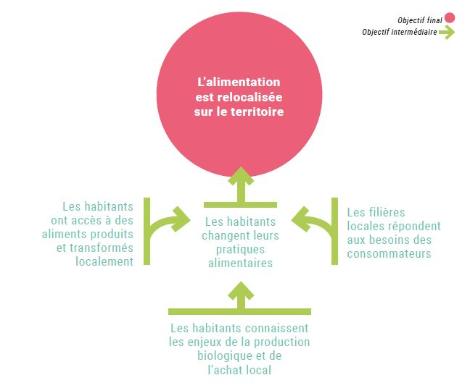Food strategy in the Biovallée
Coordinated by the Val de Drôme Community of Communes
janvier 2019
Fondation Daniel et Nina Carasso (FDNC)
Towards a Europe of territorial food systems?
This study is extracted from the analysis of twenty-two French and Spanish projects related to new food models, all highlighting different challenges.
In Spain, governance is being built, while French food systems are looking for solutions to change scale. But in both countries, accessibility remains the weak link.
In order to relocate food in the region, the Val de Drôme Community of Communes (CCVD) and its partners have decided to take action on food practices. To achieve this, three levers are used: raising awareness, supporting collective catering and linking supply and demand at local level.
Val de Drôme
The stakeholders of the Biovallée territory (26) share a common interest: to become a reference ecoterritory in terms of sustainable development. The objectives are: 50% of farmers in organic farming, halving the use of chemical inputs and 80% of organic or local products distributed in out-of-home catering. In 2011, an analysis of the territory’s agricultural offer will encourage elected officials and committed stakeholders to relocate food.
The Val de Drôme Community of Municipalities (CCVD) is responsible for the food strategy, which is divided into three areas:
-
Supporting voluntary canteens to increase the proportion of organic or local products.
-
Raising the population’s awareness of sustainable food issues.
-
Strengthening the match between supply and demand (training actions and creation of a logistics coordination platform).
The implementation of this strategy is being carried out with experienced partners already active in the area: the « Centre d’initiatives pour la valorisation de l’agriculture et du monde rural de la Drôme » (Civam 26), the Drôme organic farmers’ group (Agribiodrôme) and the Court-Circuit association (Agri Court platform).

A logistical coordination platform at the service of the territory’s stakeholders
Linking supply and demand for organic and/or local products requires a great deal of coordination between producers, restaurateurs, local authorities, etc. The Agri Court platform has undergone several changes before today, thanks to the support of its partners and the Val de Drôme Community of Communes, it has reached a situation of balance. To achieve this, economic and organisational decisions have been taken: ensuring sufficient volumes of orders by working with the collective catering sector, optimising deliveries over a dispersed territory, stopping retail sales, introducing « non-organic » producers, diversifying activities through advice and expertise… Two objectives have guided this evolution: fair remuneration for producers and reducing the drudgery of work for the platform’s employees.
A slowdown linked to the regional elections
The financial support of the Daniel and Nina Carasso Foundation is the driving force behind the Val de Drôme’s food strategy. It is based on the synergy of existing initiatives in the area. The first phase sets up a horizontal and participative governance, in order to carry out adapted actions, successfully carried out until the regional elections. After a slight slowdown, they are resuming, targeting several issues: the appropriation of actions by local actors, the opening up of governance to new entrants and the empowerment of part of the activities.